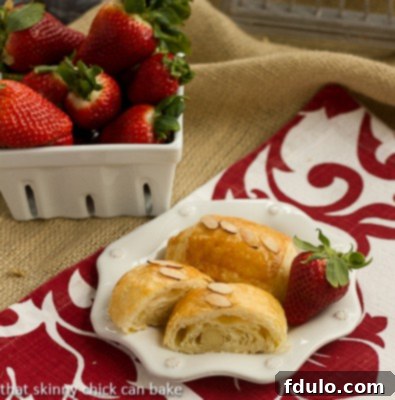Indulge your culinary spirit and embark on a delightful baking adventure with these exquisite Homemade Almond Croissants. Imagine the awe on your guests’ faces as they bite into flaky, buttery layers, expertly crafted from scratch – a true testament to the art of laminated dough. This isn’t just a recipe; it’s an invitation to master a French bakery classic right in your own kitchen.
Our Almond Croissant Recipe, also known as Croissants aux Amandes, delivers that signature buttery flakiness and rich, sweet almond paste filling, mimicking the perfection found in high-end French patisseries. Every bite is a harmonious blend of textures and flavors, promising a showstopping treat that will elevate any breakfast or dessert experience.

Why You Must Try This Homemade Almond Croissant Recipe
Baking croissants from scratch might seem daunting, but the reward is immeasurable. This particular recipe, adapted from the esteemed Dorie Greenspan, is a tried and true method that guides you through the process with clarity and precision. Here’s why mastering these Homemade Almond Croissants should be your next baking triumph:
- Master a French Delicacy: If achieving perfectly flaky, golden croissants has been on your baking bucket list, this comprehensive guide will help you tick it off. The two-day process of meticulous rolling, folding, chilling, and repeating (known as lamination) might sound involved, but it’s an incredibly satisfying journey that culminates in a truly professional-quality pastry.
- Unparalleled Flavor and Texture: Unlike store-bought alternatives, homemade croissants, especially those filled with rich almond paste, offer an unmatched depth of flavor and a delicate, airy texture. The real butter permeates every layer, creating a luxurious mouthfeel that is simply irresistible.
- Versatility at Your Fingertips: Once you’ve mastered the foundational laminated dough, a world of possibilities opens up. This versatile dough can be used to create classic plain croissants, savory filled options, or other delightful pastries beyond the almond variety. It’s a foundational skill that expands your baking repertoire significantly.
- Superior Ingredients, Superior Taste: Made with real, high-quality unsalted butter, these croissants boast a richer flavor and a more authentic, flaky crust than those made with lesser fats. You control every ingredient, ensuring a pure and delicious outcome free from unwanted additives.
- The Ultimate Baking Accomplishment: There’s immense pride in presenting a batch of warm, golden croissants, knowing you crafted every single layer. The aroma alone will transport you straight to a Parisian patisserie, and the taste will confirm your newfound baking prowess.
Essential Ingredient Notes for Perfect Croissants
Success in baking often hinges on the quality and preparation of your ingredients. For these Homemade Almond Croissants, attention to detail with each component is key to achieving that desired flaky texture and rich flavor.
- Kitchen Staples: You’ll need everyday items like milk, sugar, and salt, which play crucial roles in the dough’s structure and flavor. All-purpose flour is the backbone, and for the lustrous finish, an egg whisked with water creates the perfect egg wash.
- The Butter Dilemma – Cold, Unsalted: Butter is arguably the most critical ingredient in laminated dough. Always opt for cold, unsalted butter. European-style butter, with its higher fat content, is often preferred by professional bakers for its superior plasticity and flavor, which contributes to more distinct layers. Keeping it cold is non-negotiable; it prevents the butter from melting into the dough, ensuring those distinct, airy layers form during baking.
- Almond Paste: This sweet, pliable paste is the heart of our Almond Croissant Filling. You can typically find a small can of almond paste in the baking aisle or specialty foods section of larger supermarkets and gourmet markets. It’s distinct from marzipan, which often contains more sugar and a finer texture. Almond paste provides a more concentrated almond flavor that pairs beautifully with the buttery pastry.
- Dry Active Yeast: The original recipe may mention compressed yeast, but active dry yeast is more commonly available and works perfectly. The general conversion is 1 ounce of compressed yeast equals approximately 4 ½ teaspoons of active dry yeast. Ensure your yeast is fresh and active by blooming it in warm milk before adding it to the rest of the dough ingredients. This step guarantees your croissants will rise beautifully.

Expert Tips and Techniques for Crafting Flawless Croissants
Baking Homemade Almond Croissants is an art, but with these detailed tips, you’ll achieve professional results and truly understand the magic of laminated dough.
- Choosing Your Dough Base: While this recipe champions scratch-made laminated dough, if time is a constraint, a high-quality, all-butter premade puff pastry dough can be a suitable shortcut. Brands like Dufour are known for their butter content, which is crucial for flavor and flakiness. Be aware that yeasted croissant dough offers a unique airy texture and puff that commercial puff pastry may not fully replicate, but the results will still be delicious.
- The Golden Rule of Cold Dough: This is a cardinal rule for successful croissants. Keeping the dough cool throughout the entire lamination process is paramount for achieving the best rise and the most distinct, flaky layers. Butter melts at room temperature, and if it integrates too much with the dough, you lose those beautiful separations. If at any point your dough or butter feels too warm or soft while rolling and shaping, don’t hesitate to refrigerate it for 20-30 minutes before continuing. Patience with chilling is key to perfection.
- Filling Your Croissants – A Matter of Taste: When it comes to the filling, don’t be shy! For almond croissants, roll a thin rope of almond paste and place it strategically within your dough rectangle before shaping. The original baker wished for more filling, so learn from this experience and be generous with your almond paste for a truly satisfying bite. This rich, sweet center is what makes the Almond Croissant Recipe so special.
- Beyond Almonds – Exploring Other Fillings: Your homemade croissant dough is incredibly versatile. Chocolate is another wonderfully easy and popular filling. Use high-quality chocolate batons or chunks, ensuring they are well-encased within the dough to prevent them from oozing out during baking. You can also experiment with fruit compotes, Nutella, or even savory fillings like ham and cheese once you’ve mastered the basic technique.
- Decorative Touches for Identification and Appeal: A simple yet elegant touch is to garnish your almond-filled pastries with a few sliced almonds after applying the egg wash. This not only adds a lovely textural element and a hint of nutty flavor but also serves as a visual cue to the filling. This is especially helpful if you’re baking multiple varieties, like chocolate and almond croissants, to easily distinguish them for different preferences (like a nut-avoiding spouse!).
- Understanding Lamination: The process of “turns” involves repeatedly rolling and folding the dough and butter. Each turn creates hundreds of microscopic layers of dough separated by butter. During baking, the water in the butter turns to steam, pushing these layers apart and creating the signature airy, flaky structure of a croissant. Flour your work surface and dough lightly but consistently to prevent sticking without incorporating too much extra flour.
- Proofing for Perfection: After shaping, proofing is crucial. This is the final rise where the yeast works its magic, creating air pockets and giving the croissants their light, airy texture. An ideal proofing environment is warm (around 75-80°F or 24-27°C) and humid. A turned-off oven with a pan of hot, steamy water inside is an excellent DIY proofing box. Ensure they triple in size and feel spongy before baking – under-proofed croissants will be dense, while over-proofed ones may collapse.
- Baking to Golden Perfection: Preheat your oven thoroughly. The initial high heat is vital for a good “oven spring,” where the croissants puff rapidly. Keep a close eye on them during the final minutes of baking; you want a deep golden-brown color for maximum flavor and crispness.
I must confess, I made one of these delectable Homemade Almond Croissants disappear in no time flat while typing up this post… so it’s time to hop on the treadmill so I can have another! They are truly that addictive.

Frequently Asked Questions About Croissants and Puff Pastry
Delving into the world of laminated dough often brings up a few common questions. Here are some answers to help you on your baking journey:
The French term for puff pastry is Pâte Feuilletée. This translates literally to “flaky paste” or “leafy paste,” perfectly describing its distinct layered structure.
Puff pastry is incredibly versatile! Beyond classic croissants, it’s used for elegant desserts like Napoleons (mille-feuille) and Palmiers (elephant ears). It’s also fantastic for wrapping various fillings, from sweet fruits and creamy cheeses to savory meats and vegetables, creating stunning appetizers and main courses.
The magic of puff pastry (and croissant dough) lies in its hundreds of alternating layers of dough and butter created through repeated rolling and folding, a process called lamination. When this chilled dough is placed in a hot oven, the moisture trapped within the tiny pockets of butter rapidly turns into steam. This steam then forces the dough layers apart, causing them to puff up and separate into the characteristic light, airy, and flaky strata that make these pastries so delightful.
Croissants are truly at their peak when enjoyed fresh, ideally on the day they are baked, when their flakiness and aroma are strongest. If you need to store them longer, allow them to cool completely, then wrap them tightly in an airtight container or freezer bag and freeze for up to a month. To reheat, thaw them overnight in the refrigerator or at room temperature, then place them in a 350°F (175°C) oven for about 6-8 minutes until warmed through and crisp.
Store-bought almond paste is perfectly acceptable and widely used for convenience. However, if you’re feeling adventurous, you can make your own by blending blanched almonds with sugar, a touch of egg white, and almond extract. This allows for customization of sweetness and texture, though it adds an extra step to the process.
Tough croissant dough can often be attributed to over-working the dough, which develops too much gluten, or not allowing sufficient chilling time between turns. Inadequate flouring during rolling can also lead to excessive stretching and tearing. Ensure you knead just enough to develop elasticity, and respect those crucial chilling periods to relax the gluten and solidify the butter.
You May Also Like These Related Recipes
If you’ve enjoyed the challenge and delicious rewards of making Homemade Almond Croissants, you might be interested in exploring other recipes that feature flaky pastry or are perfect for breakfast and brunch. Expand your baking skills with these tempting options:
- Puff Pastry Cinnamon Rolls from Lauren’s Latest: A quicker take on a classic, using puff pastry for speedy cinnamon roll gratification.
- Maple Glazed Apple Tart: A delightful tart with seasonal flavors, often made even simpler with a puff pastry base.
- Puff Pastry Antipasto Squares: A savory and impressive appetizer, showcasing the versatility of puff pastry for non-sweet applications.
- Sausage Croissant French Toast Casserole: An inventive and hearty brunch dish that makes excellent use of day-old croissants.
- French Apple Tart with Puff Pastry: Another elegant dessert featuring fruit and the crisp layers of puff pastry.
- More Breakfast and Brunch Recipes: Explore a wider collection of morning meal ideas that are perfect for entertaining or a special treat.
Stay connected for more baking inspiration through social media @ Instagram, Facebook, and Pinterest. Don’t forget to tag me when you try one of my recipes! And if you love the results, please consider leaving a 5-star rating and comment on the blog or in the recipe card below.
Homemade Almond Croissants Recipe Card
An exquisite treat with homemade laminated dough filled with sweet almond paste, perfect for elevating any breakfast or dessert occasion!

Recipe Overview
- Prep Time: 40 minutes
- Cook Time: 12 minutes
- Additional Time: 7 hours (for chilling and proofing)
- Total Time: 7 hours 52 minutes
- Yield: 8 croissants
Ingredients
For the Croissant Dough:
- 4 ½ teaspoons active dry yeast
- 1 + cup warm milk (add more if needed, see instructions)
- 3 ¾ cups unbleached all-purpose flour
- ⅓ cup granulated sugar
- 2 teaspoons salt
For the Butter Block:
- 4 ½ sticks (1 pound 2 ounces) cold unsalted butter, cut into 1/2 inch cubes
- 2 tablespoons unbleached all-purpose flour
For the Egg Wash:
- 1 large egg, beaten with 1 tablespoon cold water
For the Almond Paste Filling:
- Small can of almond paste (enough for 8 portions)
Instructions
- Activate Yeast: In a small bowl, add the active dry yeast to the warm milk. Stir gently and let it sit for 5-10 minutes until it becomes foamy, indicating the yeast is active and blooming.
- Prepare Dough: In the bowl of a stand mixer fitted with a dough hook, combine the flour, sugar, salt, and the bloomed milk-yeast mixture (starting with 1 cup of milk). With the machine on its lowest speed, mix for 1 to 2 minutes, until a soft, moist dough forms and collects around the hook.
- Adjust Dough Consistency: Carefully assess the dough’s hydration. If it appears too dry or if there’s unmixed flour at the bottom of the bowl, gradually add more milk, 1 tablespoon at a time, until all the flour is moistened and the dough is soft, cohesive, and gathers on the hook. (The original baker noted adding almost 6 additional tablespoons).
- Knead Dough: Increase the mixer speed to the highest setting recommended by your manufacturer for dough (typically speed 2 on a KitchenAid). Knead the dough for several minutes until it becomes smooth, elastic, no longer sticky to the touch, and has a consistency similar to soft butter. This ensures proper gluten development for a pliable dough.
- First Dough Chill: Remove the kneaded dough from the mixer. Place it in a plastic bag, leaving a bit of space for it to expand. Allow the dough to rest at room temperature for 30 minutes, then refrigerate for a minimum of 8 hours, or ideally, overnight. This initial chilling is crucial for firming the dough and allowing flavors to develop.
- Prepare Butter Block: Attach the paddle attachment to your mixer. Add the cold, 1/2-inch cubed unsalted butter and the 2 tablespoons of flour to the bowl. Beat on the highest speed for about 2 minutes, or until the butter mixture is smooth, pliable, and reaches a consistency similar to your chilled croissant dough. This ensures the butter can be easily incorporated without tearing the dough.
- Shape Butter Block: Transfer the beaten butter onto a large piece of plastic wrap. Gently flatten it and give it a few slaps to remove any trapped air. Then, shape it into an even oval, approximately 5 to 6 inches long and 1 inch thick. Wrap it tightly in the plastic wrap and refrigerate until thoroughly chilled and firm.
- Incorporate Butter – Initial Roll: Lightly flour a spacious work surface. Take the chilled croissant dough and dust its top lightly with flour. Using a long rolling pin, roll the dough into an oval shape, approximately 10 inches wide and 17 inches long.
- Encapsulate Butter: Carefully unwrap the chilled butter oval and center it across the middle of your rolled-out dough oval. Fold the top and bottom sections of the dough over the butter, creating a neat package. Gently stretch the folded layers of dough out to the sides and firmly press all the edges to completely seal the butter within the dough.
- Distribute Butter: Using your rolling pin, gently yet firmly start “whacking” the dough package to begin distributing the butter evenly within. Rotate the dough by 90 degrees and pound it again in the other direction. You should observe the butter gradually moving and spreading towards the edges of the dough.
- Initial Rectangle: After this initial pounding, you should have a relatively even, 1-inch thick rectangle, roughly 14 inches long and 6 inches wide.
- First Turn – Rolling: Ensure your work surface and the top of the dough remain well-floured throughout this step. Roll the dough into a large rectangle, approximately 24 to 26 inches long and about 14 inches wide, with the longest side facing you. If at any point the dough or butter begins to feel warm or soft, stop and refrigerate it for an hour or two to prevent the butter from melting into the dough.
- First Turn – Folding: Using a pastry brush, gently brush off any excess flour from the surface of the dough. Working from both the left and right sides, fold the dough inward into thirds, similar to how you would fold a brochure. This will result in a compact package about 8 inches wide by 14 inches long.
- First Chill: Carefully transfer the folded dough onto a parchment-lined baking sheet. Cover it tightly with plastic wrap and refrigerate for at least 2 hours. It’s helpful to write “Turn 1” on the parchment paper to keep track of your progress.
- Second Turn: Remove the dough from the refrigerator. Position it so that the 14-inch side runs from your left to your right. Re-flour your work surface and the top of the dough. Roll the dough again, just as you did before, into a rectangle 24 to 26 inches long by approximately 14 inches wide. Do not worry if the dough shows slight cracks during these subsequent turns; this is normal as the layers develop.
- Second Fold & Chill: Brush off excess flour. Fold the dough into thirds once more. Place it back on the parchment, mark the paper “Turn 2,” cover, and refrigerate for at least another 2 hours.
- Third Turn: For the final turn, remove the dough and orient it with the 14-inch side running from left to right. Roll the dough into a rectangle approximately 24 inches long by 14 inches wide. Fold the left and right sides of the dough inward towards the center, leaving a small gap in the middle. Then, fold one side over the other, as though you are closing a book. This creates an extra compact fold.
- Final Dough Chill: Brush off any remaining flour. Wrap the dough tightly in plastic wrap and refrigerate for a minimum of 2 hours, or for best results and easier handling, refrigerate it overnight. This extended chill is vital for the butter to firm up completely and the gluten to relax.
- Prepare for Shaping: Flour your work surface generously. Place the thoroughly chilled dough so that its “spine” (the tightly folded edge) is to your left and the opening is to your right, resembling a closed book. For easier handling, cut the dough in half horizontally, creating two pieces, each about 7 inches long and 6 ½ inches wide. Wrap and chill one half while you work with the other. Any extra dough can be wrapped tightly and frozen for later use.
- Final Roll for Shaping: Take one half of the dough. Flour it generously and roll it into a large, thin rectangle, approximately 24 to 26 inches long and 15 to 18 inches wide. This step requires a good deal of effort and consistent re-flouring to prevent sticking. If necessary, turn the dough so the longest side runs horizontally along your counter. Carefully fold the top half of the dough down to the bottom, effectively halving its width.
- Cut Croissants: Line two large baking sheets with parchment paper. When your dough is rolled and ready, measure off 3 to 4-inch wide strips, cutting the dough from bottom to top in straight lines. Unfold each strip, then cut it crosswise in half to create rectangular or slightly trapezoidal pieces, depending on your desired croissant shape.
- Fill and Shape: Take a small, rolled piece of almond paste (adjust quantity based on preference; remember the advice to use more for a richer flavor!) and place it at the wider end of each dough strip. Tightly roll the dough into a coil, ensuring the seam finishes facing down. Continue shaping the remaining croissants in the same manner.
- Proofing: Arrange the shaped croissants on the prepared baking sheets. Brush the tops lightly with the reserved egg wash and garnish with a few sliced almonds. Allow them to rise, uncovered, at room temperature for 3 to 4 hours, or until they have visibly tripled in size and feel soft and spongy to the touch. An excellent environment for proofing is a turned-off oven with a pan of hot, steamy water placed on the bottom rack. (Keep any remaining egg wash covered in the refrigerator).
- Bake: Preheat your oven to 350°F (175°C). Gently brush the proofed croissants with egg wash one final time. Bake for 12 minutes, then rotate the baking sheets from front to back to ensure even baking. Continue baking for an additional 4 to 6 minutes, or until the croissants are beautifully puffed and deeply golden brown.
- Cool & Serve: Once baked, transfer the golden croissants to wire racks and allow them to cool for a few minutes before indulging. Enjoy them warm!
- Storing: For the absolute best experience, consume these Homemade Almond Croissants on the day they are made. If you wish to store them longer, allow them to cool completely, then wrap them tightly in an airtight container or freezer bag and freeze for up to one month. To reheat, thaw the frozen croissants overnight in the refrigerator or at room temperature, then warm them in a 350°F (175°C) oven for approximately 8 minutes until crisp and fragrant.
Notes
Source: This exquisite recipe is inspired by “Baking with Julia: Savor the Joys of Baking with America’s Best Bakers.”
Nutrition Information (per 1 croissant serving)
(Approximate values based on recipe ingredients)
- Yield: 8 servings
- Serving Size: 1 croissant
- Calories: 450
- Total Fat: 14g
- Saturated Fat: 7g
- Trans Fat: 0g
- Unsaturated Fat: 6g
- Cholesterol: 79mg
- Sodium: 650mg
- Total Carbohydrates: 67g
- Dietary Fiber: 4g
- Sugars: 11g
- Protein: 14g
Did you love this recipe? We’d be thrilled if you left a comment on the blog or shared a photo on Pinterest!
